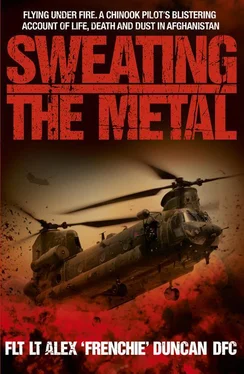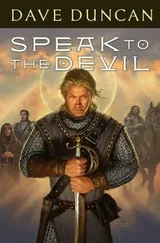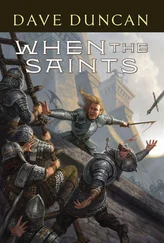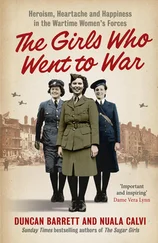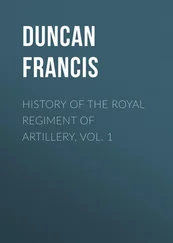It’s the first time I’ve landed in an enemy compound and I can feel my heart pounding in my chest. It isn’t always about what happens; more often it’s about the expectation, the foreknowledge there are people out there with weapons locked and loaded and pointed at you. The Taliban are synonymous with Rocket Propelled Grenades or RPGs – a weapon we very much fear because they could really ruin our day.
RPGs are exceptionally light, portable and easy to operate. The launcher is little more than a 3ft steel pipe with a grip and trigger about halfway along and a cone at the rear to dissipate the blast that a round produces on launch. They fire unguided rockets carrying a high-explosive warhead that detonates on impact. They were designed as anti-tank weapons, but being inert and non-sentient they don’t get hung up on what they’re used against. One of those hitting a Chinook is either going to break the cab in two or blow us out of the sky. Neither option is particularly appealing. The downside for the operator is that they’re inaccurate over distance, so he needs to be quite close to the target to have any chance of a hit. That means he’s going to be exposed and visible.
My eyes are darting all over the front and sides of the aircraft looking for threats – enemy gunmen or RPGs lining up or coming out of the wood line immediately ahead of us.
‘Come on,’ I say out loud. We’re a sitting duck here, except we’re loaded with ammunition for the guns and 1,600kg of fuel, so we’re like a duck sitting on a bomb.
As soon as the Paras’ feet touch the ground, the radio sparks into life with calls of ‘Contact, Contact!’ as they’re engaged. So much for the intelligence that said resistance should be light to non-existent. There are enemy in various positions and the Paras are taking heavy fire from inside the compound. We’re immediately behind them so that means we’re taking fire too.
‘Scan your arcs, guys. If you see a threat, take it out,’ Craig warns the crewmen. It’s daylight, so tracer doesn’t show and you can’t hear the telltale ‘crack’ of rounds coming in over the noise of the blades. The only way you know you’re taking fire is either from the ‘tink’ sound that rounds make when they penetrate the skin of the aircraft, or the spiderweb of cracked glass that occurs when they hit the windscreen or chin bubble. Basically, you’re either going to be dead or wise after the event. I think the only thing that saves us that day is the fact that we are shielded from view of the enemy by the height of the compound wall.
‘Ramp up, clear above and behind,’ from the back. And not a second too soon.
‘Pulling power, lifting,’ says Craig and we’re up.
Due to concerns over dust from Andy’s aircraft, the brief is for us to depart to our 12 o’clock for a sharp left-hand turn followed by a climb to fly south at height, but Craig decides that, as there is no dust, he’s going to depart with a right-hand turn and fly over a 1,500ft high range of hills to the East of Now Zad and hold in this area. It’s a spur-of-the-moment decision, made on impulse, that quite possibly saves our lives. As we later learn, an enemy team were dug in with an RPG at around the point where, had we departed and turned left as briefed, we’d have been flying at 50ft at around 20kts. Had we followed our planned route, we’d have been low and slow, directly over them at the most vulnerable stage of our departure, giving the RPG firer an unobstructed shot at the cab’s underside. It would have been like shooting fish in a barrel. Unfortunately for the Taliban, the team was overrun and killed by Paras.
Meanwhile, Lt Col Tootal had discovered that the Chinook is a far from ideal Command and Control platform, due to its poor comms fit (no secure radio at that time) and poor visibility. Nichol therefore landed near to where ‘A’ company had been inserted and the 3 Para CO joined Major Will Pike, ‘A’ Company’s officer commanding on the ground, where he felt better able to coordinate events. Nichol was called in to extract a Taliban prisoner so he returned to Bastion.
We fly a holding pattern for a while in case we are required to perform a medevac, but our fuel level gets dangerously close to bingo so we return to Bastion and shut down. The plan is for us to stand down and be ready to lift again three hours later to extract the Paras but as the aphorism goes, no battle plan survives first contact with the enemy. At this point, all the ground units – Patrols Platoon, ‘A’ Company, the Ghurkhas and ANP – are engaged in protracted firefights with large numbers of determined enemy forces.
There is no proper pan at Bastion at this stage, so the cabs just sit on what is essentially a large gravel pit. We don’t know when we’ll be required so we stay close, removing our helmets and body armour and wearing our flying suits tied around our waists. We gather by our cabs and chat among ourselves, releasing the pent-up tension that’s left over when the adrenaline subsides. We debrief, talking about how well the mission went, what lessons we’ve learned, what we can do better next time.
Mark Heal and Dave Stewart missed their target and ended up landing in the wrong compound about 300 metres away from where they were supposed to be. Nobody died; their element of ‘A’ Company worked out where they were and made their way over the ground to their starting position, but it’s an easy mistake to make out there – it’s an exceptionally difficult place to navigate in and you’re relying on the GPS, which in Mark and Dave’s case was running on the wrong setting. Aviation has to be a no-blame culture. That way, everyone is honest about their mistakes and you learn from them. It can, and does, happen to everyone.
We see the first two Apaches return for rearming and refuelling so we know that the fighting is pretty hardcore. This is the first time the Apaches have been used in anger out here but word is that they have impressed both the pilots and, perhaps more importantly, the guys on the ground. It was reported that there were many in the MoD, Government and the military who wondered where the Apaches could possibly fit in the great scheme of things. They had the potential to be another military white elephant, but very quickly they are proving themselves adaptable, fearsome and indispensable.
Eventually, we get the call and lift off to return to Now Zad. About ten miles out, I see a massive cloud of black smoke hovering in the haze. I’m wondering what has caused it and thinking there must have been the mightiest firefight. Is it a vehicle? Is it on our side, or the enemy’s? It turns out that it’s a very dry field that has just taken the wrath of an Apache’s 30mm HE cannon. Several Taliban lay dead in it and the tinder-dry stubble has caught fire.
By this point, Craig and I have progressed to the west side of the town at height and are looking down on events below, when I become aware of a voice over the radio coordinating close air support down on the ground. Its call sign is Widow Seven Zero, a Joint Terminal Air Controller or JTAC, known colloquially as a Forward Air Controller. The call sign belongs to Flt Lt Matt Carter, an officer in the RAF Regiment attached to 3 Para who will go on to be awarded the Military Cross in part for his actions on this mission.
He was with Patrols Platoon. They had come under heavy contact from a number of enemy combatants based in and around a farmhouse. The platoon had got to within a few metres of the house but then became pinned down in two groups behind two walls, separated by a gap of about fifty metres. He was trying to call in some air support to deal with the guys in the farmhouse but was unable to at that stage because he couldn’t be certain of the Paras’ exact locations. Also, the walls they were taking cover behind were only thirty metres away from the house so they were Danger Close – missiles, rockets and cannon don’t discriminate between friendly and enemy forces. The only way he could be sure was to run through the gap to see for himself.
Читать дальше
